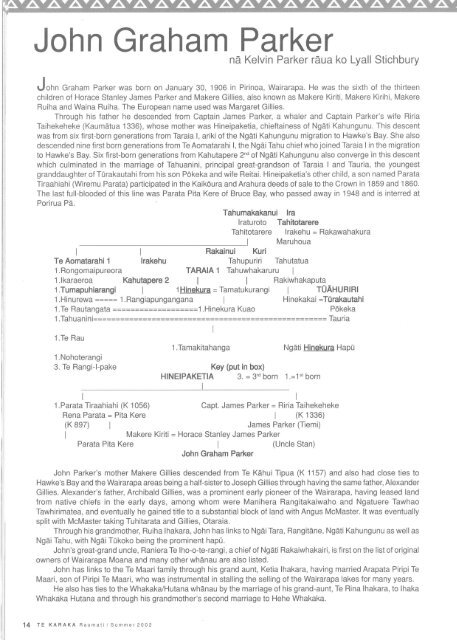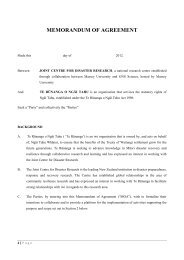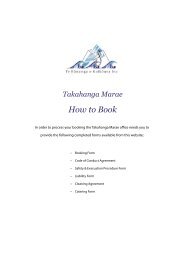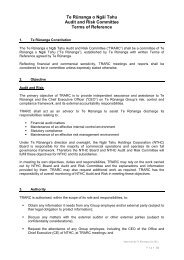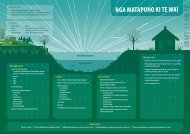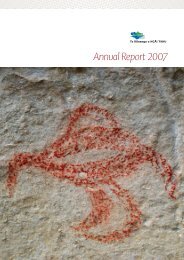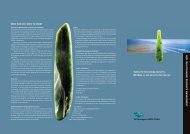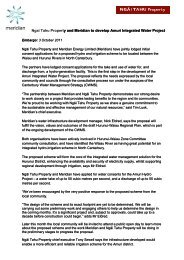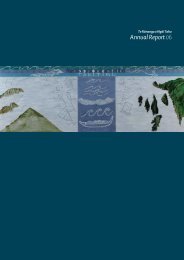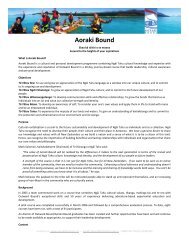You also want an ePaper? Increase the reach of your titles
YUMPU automatically turns print PDFs into web optimized ePapers that Google loves.
John Graham Parkerna Kelvin Parker raua ko Lyall StichburyJOhn Graham Parker was born on January 30, 1906 in Pirinoa, Wairarapa. He was the sixth of the thirteenchildren of Horace Stanley James Parker and Makere Gillies, also known as Makere Kiriti, Makere Kirihi, MakereRuiha and Waina Ruiha. The European name used was Margaret Gillies.Through his father he descended from Captain James Parker, a whaler and Captain Parker's wife RiriaTaihekeheke (Kaumatua 1336), whose mother was Hineipaketia, chieftainess of Ngati Kahungunu. This descentwas from six first-born generations from Taraia I, ariki of the Ngati Kahungunu migration to Hawke's Bay. She alsodescended nine first born generations from <strong>Te</strong> Aomatarahi I, the <strong>Ngai</strong> <strong>Tahu</strong> chief who joined Taraia I in the migrationto Hawke's Bay. Six first-born generations from Kahutapere 2 nd of Ngati Kahungunu also converge in this descentwhich culminated in the marriage of <strong>Tahu</strong>anini, principal great-grandson of Taraia I and Tauria, the youngestgranddaughter of TOrakautahi from his son Pokeka and wife Reitai. Hineipaketia's other child, a son named ParataTiraahiahi (Wiremu Parata) participated in the Kaikoura and Arahura deeds of sale to the Crown in 1859 and 1860.The last full-blooded of this line was Parata Pita Kere of Bruce Bay, who passed away in 1948 and is interred atPorirua Pa.<strong>Tahu</strong>makakanui IraIraturoto TahitotarereTahitotarere Irakehu = Rakawahakura_________________1 MaruhouaI 1 Rakainui Kuri<strong>Te</strong> Aomatarahi 1 Irakehu <strong>Tahu</strong>puriri <strong>Tahu</strong>tatua1.Rongomaipureora TARAIA 1 <strong>Tahu</strong>whakaruru I1.Ikaraeroa Kahutapere 2 I I Rakiwhakaputa1.Tumapuhiarangi 1 1Hinekura = Tamatukurangi I TOAHURIRI1.Hinurewa ===== 1.Rangiapungangana I Hinekakai =TOrakautahi1.<strong>Te</strong> Rautangata ===================1.Hinekura KuaoPokeka1.<strong>Tahu</strong>anini==================================================== Tauria1.<strong>Te</strong> Rau1.Nohoterangi3. <strong>Te</strong> Rangi-I-pake1.TamakitahangaNgati Hinekura HapOKey (put in box)HINEIPAKETIA 3. = 3'd born 1.=1 51 born------ ---1--------111.Parata Tiraahiahi (K 1056)Capt. James Parker = Riria TaihekehekeRena Parata = Pita KereI (K 1336)(K 897) 1James Parker (Tiemi)IMakere Kiriti = Horace Stanley James ParkerParata Pita Kere 1 (Uncle Stan)John Graham ParkerIJohn Parker's mother Makere Gillies descended from <strong>Te</strong> Kahui Tipua (K 1157) and also had close ties toHawke's Bay and the Wairarapa areas being a half-sister to Joseph Gillies through having the same father, AlexanderGillies. Alexander's father, Archibald Gillies, was a prominent early pioneer of the Wairarapa, having leased landfrom native chiefs in the early days, among whom were Manihera Rangitakaiwaho and Ngatuere TawhaoTawhirimatea, and eventually he gained title to a substantial block of land with Angus McMaster. It was eventuallysplit with McMaster taking Tuhitarata and Gillies, Otaraia.Through his grandmother, Ruiha Ihakara, John has links to <strong>Ngai</strong> Tara, Rangitane, Ngati Kahungunu as well as<strong>Ngai</strong> <strong>Tahu</strong>, with <strong>Ngai</strong> TOkoko being the prominent hapO.John's great-grand uncle, Raniera <strong>Te</strong> Iho-o-te-rangi, a chief of Ngati Rakaiwhakairi, is first on the list of originalowners of Wairarapa Moana and many other whanau are also listed.John has links to the <strong>Te</strong> Maari family through his grand aunt, Ketia Ihakara, having married Arapata Piripi <strong>Te</strong>Maari, son of Piripi <strong>Te</strong> Maari, who was instrumental in stalling the selling of the Wairarapa lakes for many years.He also has ties to the WhakakalHutana whanau by the marriage of his grand-aunt, <strong>Te</strong> Rina Ihakara, to IhakaWhakaka Hutana and through his grandmother's second marriage to Hehe Whakaka.John came from a farmingbackground, his parents having variousfarms in the Wairarapa area. Heremembers fondly a time at the farm inPirinoa (TOranganui) where he fell over abluff. He was found some time later by hisfather and taken back to the homesteadon horseback covered in scratches andscrapes. He was often getting intomischief, but claims that it was his sisterNellie who "was the number one mischiefmakerin the family".After attending Pirinoa School in 1915it became evident to his parents that hehad a hearing problem and so in 1916 hismother took him on the ferry toChristchurch and to the Sumner School forthe Deaf, now Van Asch College, wherehe was enrolled on February 5, 1916. He recalls being very frightened by the strange children milling around himand waving their hands around when he arrived there and was most upset when his mother left him to return to theNorth Island.Eventually he settled in and after a time due to his farming background was put in charge of the school's fourcows. His lodgings were a double-skinned army tent with wooden floor situated under a tree which he reports wasqUite comfortable and gave him a certain amount of freedom that other children did not have. In the school holidayshe would walk up the Summit Road, through Lyttelton and round to Rapaki, a journey of some distance and wouldstay with his cousins, Robert and Raukura Gillies or the Hutana whanau. He returned to the school recently and asthe oldest surviving past pupil opened the new museum there.He left school on July 4, 1924 and returned to the Wairarapa where he worked for an Arthur Wilkie, his brotherMartin Parker and another brother Alf Parker on their farms before getting a job in a cheese factory. While at the"Waihak'" factory with his brother Hilton, he won awards for his cheeses. He also worked with brother Alf in theCollingwood Cheese Factory at the top of South Island, and later worked in cheese factories at Pigeon Bay andBarry's Bay on Banks Peninsula.Over the years he also worked at Packer & Jones, a box-making factory, Aulsebrooks Biscuits, where he wasforeman for a time, and Christchurch City Council Parks & Reserves where he worked until he retired about 1966.John remembers fondly time spent with his mother after she moved to Lyall Bay in Wellington. He recallsgathering seafood with her, her skirts tucked into her underwear, around the rocks not far from his home and onone occasion being bowled over by a rogue wave and returning home really wet and cold.Being a sporting person, John had played soccer at the School for the Deaf, participating in the Christchurchcompetition where, his team had considerable success against their bigger opponents. Being the team's starstriker, his coach, Mr Dick, would often tell him to go and make himself scarce before a big match and he would getsomeone else to do his farming chores. John remembers playing with and against Bill Merritt, later to become aCanterbury and New Zealand cricket player and Vic Smith, another prominent Canterbury soccer player.When he returned to the Wairarapa he joined the Carterton Association Football Club and played in the 193436 seasons, being a prolific goal-scorer and gaining representative honours for Wairarapa over that period, thehighlight being his selection in the Wairarapa team that played against the touring Australian side in 1936.In "A History of the Carterton Association Football Club" being prepared by Robert R Eagle, the author states:"He came from the well-known Parker family of the Carterton district. His brothers Martin, Stan, Hilton andtheir families were well known in rugby circles as well as being prolific sports people in other sports throughout theWairarapa. While interviewing John, I learned JP was deaf! This last remark made this person to be someone veryspecial! No other player in the club has played in its colours with the handicap that Johnny had. How he could haveplayed among his fellow players, opposition or referees without being able to hear them is amazing. No doubtsome referee's whistles could go unheeded ... perhaps to JP's advantage".Sporting prowess has continued in John's whanau. His great-grandnephew Adam Parker rose rapidly through theranks of Canterbury rugby in 1998, playing for Sydenham before being named in the New Zealand Maori side toplay Tonga, and after taking that huge step, England. They were undefeated, and Adam left NZ to take up acontract with the Toshiba Club in Japan soon after. Adam is in the Japanese squad for the Rugby World Cup <strong>20</strong>03so watch out for him when Japan plays.Sonny Parker, another great-grandnephew, played in the NZ Maori Colts curtain-raisers to the Tongan andEngland games. Sonny then went to Italy to further his rugby career and while there was brought to the attention ofGraham Henry, who took him to Wales, where he played for the Pontypridd Club. Recently having served his threecont.on page 31 ~14 TE KARAKA Raumali I Summer <strong>20</strong>02 Raumali ISummer <strong>20</strong>02 TE KARAKA 15


